Publication > Research Gallery > Extragalactic Astronomy
Research Gallery
Extragalactic Astronomy
 |
The distance distributions of bright dusty star-forming galaxies Overview of the ALMA spectra plotted in their rest-frame frequencies from a complete sample of bright dusty star-forming galaxies, or the submillimeter galaxies (SMGs), that were undergoing very active phases ...(more) |
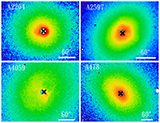 |
Systematic Perturbations of the Thermodynamic Properties in Cool Cores of HIFLUGCS Galaxy Clusters Thumbnails showing the Chandra X-ray brightness distribution in the 0.5 - 7.0 keV band for 28 systems selected from the HIFLUGS sample. The color bar indicates the X-ray surface brightness ...(more) |
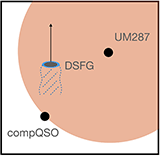 |
A dusty star-forming galaxy experiencing ram-pressure stripping in one of the most massive galaxy systems at cosmic noon A dusty star-forming galaxy (DSFG) was discovered in the halo of a quasar pair system UM287, which also hosts an enormous Lyman-alpha nebula (ELAN). With observational evidence here is a ...(more) |
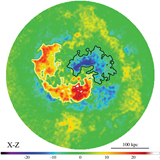 |
Gas Density Perturbations in the Cool Cores of CLASH Galaxy Clusters Top: X-ray surface brightness of the galaxy cluster MACS J1311.0-0310 taken by the Chandra X-ray Observatory (left) and its X-ray residual image after removing the mean profile (right). Bottom: X-ray ...(more) |
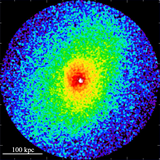 |
Line-of-Sight Gas Sloshing in the Cool Core of Abell 907 Left: X-ray surface brightness of the galaxy cluster Abell 907 taken by the Chandra X-ray Observatory. Right: Residual image of X-ray surface brightness after subtracting its global profile from the ...(more) |
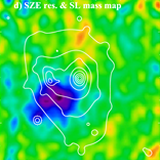 |
A Cool Core Disturbed: Observational Evidence for the Coexistence of Subsonic Sloshing Gas and Stripped Shock-heated Gas around the Core of RX J1347.5-1145 Top Left: X-ray surface brightness of the galaxy cluster RX J1347.5-1145 taken by the Chandra X-ray Observatory. The white contours show the surface mass density map of this galaxy cluster ...(more) |
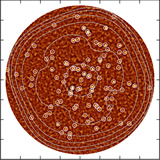 |
STUDIES (SCUBA-2 Ultra Deep Imaging EAO Survey) STUDIES is a multi-year JCMT Large Program, to obtain extremely deep submillimeter images of the distant universe. The goal is to understand the origin of the far-infrared cosmic background radiation ...(more) |
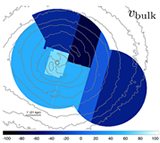 |
Atmospheric gas dynamics in the Perseus cluster observed with Hitomi Left: Bulk velocity (v_bulk) map of the intracluster medium in the core of the X-ray brightest galaxy cluster, the Perseus cluster, with respect to the redshift z = 0.017284 (heliocentric ...(more) |
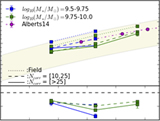 |
First results on the cluster galaxy population from the Subaru Hyper Suprime-Cam survey. I. The role of group or cluster environment in star formation quenching from z = 0.2 to 1.1 Top: Median sSFR of SF galaxies as a function of redshift in the field (dotted), groups (dashed), and clusters (solid). Bottom: The logarithmic ratio of sSFR for group to field ...(more) |
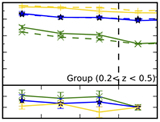 |
The Pan-STARRS1 Medium-deep Survey: Star Formation Quenching in Group and Cluster Environments Top: The quiescent fraction from the radial (solid lines) and density (dashed lines) contribution. Three stellar mass ranges are plotted: 10.1 |
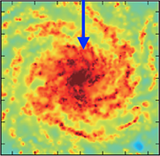 |
Dust evolution simulation in a spiral galaxy We simulated the evolution of a spiral galaxy with N-body/SPH (Aoyama, Hou, Hirashita, et al. 2017). We implemented the evolution of dust in the simulation. This figure shows the face-on ...(more) |
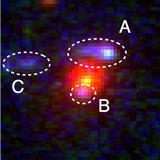 |
Discovery of a Strong Lens Galaxy Embedded in a Cluster at z = 1.62 Hubble Space Telescope image of the most distant strong lensing galaxy known at z = 1.62. ...(more) |
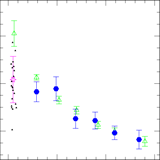 |
Predictions of the stellar mass growth of BCGs The green triangles represent predictions of the stellar mass growth of BCGs by a highly successful galaxy formation model (Guo et al. 2011), which are found to agree fairly well ...(more) |
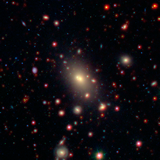 |
BCG a picture of a galaxy cluster observed by the WISE and Spitzer Space Telescopes. The bright galaxy at the center is the BCG. ...(more) |
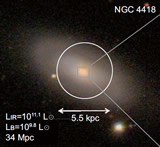 |
Gauging the Hidden Hot Nucleus of NGC 4418 with submillimeter Interferometry NGC 4418 is nearby luminous infrared galaxy whose nucleus is deeply shrouded in dust. ...(more) |
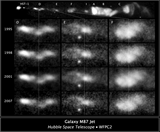 |
Hubble Takes Movies of Space Slinky in M87 This sequence of images, taken over a 13-year span by NASA's Hubble Space Telescope, reveals changes in a black-hole-powered jet of hot gas in the giant elliptical galaxy M87. The ...(more) |
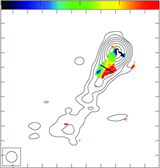 |
Rotation measure gradient in 3C 216 Left: VLBA rotation measure (RM) map of 3C 216 from 12 to 24 GHz. A clear gradient transverse to the direction of the jet is observed. Thick line indicates the ...(more) |
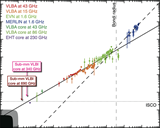 |
Toward the Innermost Region of the Relativistic Jet from Supermassive Black Hole in the Active Galactic Nuclues M87 Global structure of the M87 jet is examined by multi-frequency observations. Figure shows that distribution of the radius ($r$) of the jet as a function of the de-projected distance ($z$) ...(more) |
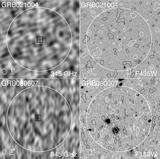 |
The first ALMA-Taiwan result published with Cycle 0 data The first ALMA-Taiwan result published with Cycle 0 data. Gamma-ray burst host galaxies are observed at 345 GHz with ALMA (left panels) and compared to Hubble Space Telescope images (right). ...(more) |
 |
Comparing optical and radio polarization angles of the quasar 1954+513 Left: Rotation Measure (RM) of 1954+513. The leftmost red dot indicates electric vector position angle in optical, whilst the black dots indicate radio measurements at 12, 15, 22, 24 and ...(more) |
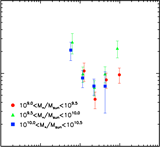 |
Clustering radius vs. specific star formation rate of z ~ 2 star forming galaxies For galaxies with SSFR smaller than this critical point, the hosting halo mass increases, implying that the environmental quenching effect has taken place as early as z ~ 2. On ...(more) |
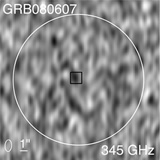 |
ALMA Detection of the Host Galaxy of gamma-Ray Burst GRB 080607 GRB 080607 is a gamma-ray burst from the distant universe of 12 billion light year away (z = 3.036). It is also a dark burst, whose optical light is strongly ...(more) |
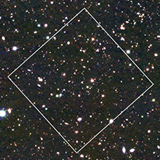 |
The center of the TENIS field. In this color picture, blue is the Hubble Space Telescope z-band image, green is our TENIS J-band image, and red is TENIS Ks-band image. The square is the famous Hubble ...(more) |
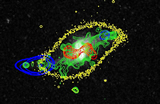 |
NGC3801: AGN-feedback caught in the act. Panchromatic summary of NGC3801 showing radio continuum from VLA (red contours), HI-emission from VLA (blue), 8 micron dust/PAH emission from Spitzer (gray scale), r'-band optical image from SDSS (yellow single ...(more) |
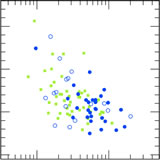 |
Baryon Content of Galaxy Clusters at z=0-0.6 The upper panel shows the baryon mass fraction, while the lower panel shows the stellar mass fraction. The solid and open circles are clusters from two different z=0.1-0.6 samples, and ...(more) |
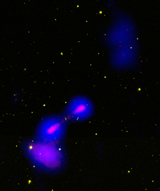 |
Discovery of a spiral-host episodic radio galaxy An exotic galaxy nick-named 'Speca' (Spiral-host Episodic radio-galaxy(AGN) tracing Cluster Accretion) has been discovered. Above is the composite image of Speca: Optical SDSS image of the galaxies in yellow, low ...(more) |
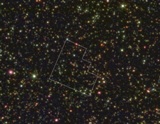 |
Infrared Hubble Deep Field Hubble Deep Feild and its surrounding field in the infrared. The color image is a combination and deep images taken at 2.1 um (blue) by CFHT, 3.6 and 4.5 um ...(more) |
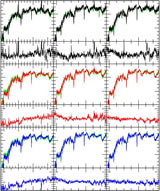 |
On the Populations of Radio Galaxies with Extended Morphology at z < 0.3 Mean SDSS spectra of RGs of different morphologies and different SMBH masses. From left to right, the columns are of increasing ranges of SMBH mass. Within each column, the top ...(more) |
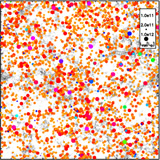 |
A simple approach to the high-redshift sub-millimeter galaxies Simulated galaxy distribution. Each point corresponds to an individual galaxy, whose luminosity of dust emission at a submillimeter wavelength of 0.85mm is calculated individually. Therefore, the figure predicts the early ...(more) |
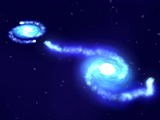 |
Interacting Galaxies An Artist's Conception of Interacting Galaxies ...(more) |
 |
Multi-transition CO images toward the Whirlpool galaxy M51 Multi-transition CO images toward the Whirlpool galaxy M51. The images show stronger intensity toward the nucleus in the higher CO transitions, suggesting that the molecular gas around the AGN is ...(more) |
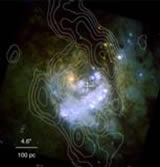 |
The center of a nearby barred galaxy M83 The center of a nearby barred galaxy M83. The SMA data in contours show the distribution of cold gas along dust lanes and a starburst ring (Sakamoto et al. 2004, ...(more) |
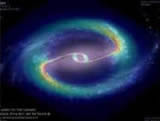 |
Numerical simulation of the structure of NGC 1300 under a strong bar potential Numerical simulation of the structure of NGC 1300 under a strong bar potential. The figures from left to right are the numerical result, observation, and their superposition, respectively. ...(more) |
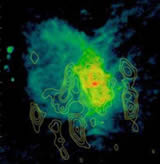 |
The Galactic Center Left: Highest resolution (0.0002") image ever obtained of the Galactic Center via VLBA observations at 3mm. The slight extension in the east-west direction shows that emission is resolved at 20 ...(more) |
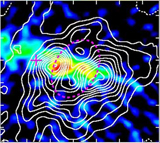 |
Active star formation Active star formation at the inner edge of an expanding molecular bubble near the center of M82 (Matsushita et al. 2000, ApJ, 545, L107, Matsushita et al. 2005, ApJ, 618, ...(more) |
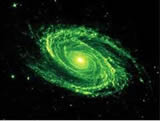 |
omparison between a numerical simulation result and M81 Comparison between a numerical simulation result (left) and M81 (right). M81 is a well studied case of spiral stellar potential driven shock and star formation. The secondary spiral structure observed ...(more) |
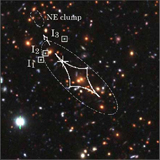 |
Subaru/Suprime-Cam image of the distant cluster RXJ0152 at z=0.83 Top: Measurements of C, N, O and S isotopic abundance ratios in the arm of a spiral galaxy at a redshift of z=0.89 using the Plateau de Bure Interferometer. The ...(more) |